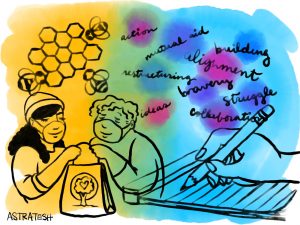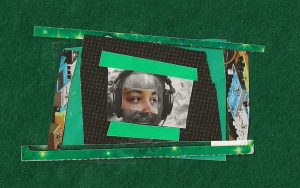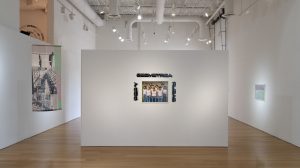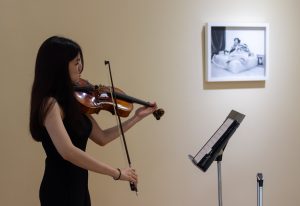“Beyond the Page” digs into the process and practice of writers and artists who work at the intersection of literary arts and other fields. In February, I was excited to speak with “rural hip-hop blues” artist Saleem Hue Penny—whose work I have long admired—about his recent poetry chapbook and its audio companion, his process for creating within and across multiple media, and his work’s relationship to place, childhood, and the natural world.
Follow @huedotart to hear about future readings, including the “Tammy Journal Takeover” at Pilsen Community Books this spring. This interview has been edited for length and clarity.
Marya Spont-Lemus: You call yourself a “rural hip-hop blues” artist. How did you come to that framing for you and your work and what does it mean to you?
Saleem Hue Penny: So I have traditionally used the acronym “h.u.e.”, for “hope uplifts everything.” It’s a double-play on my middle name, of Hue. My mother gave it to my little brother and me because we’re different shades in a bigger picture. And at some point I was like, “Well, what is the through-line in my work?” There’s always some sense of hope—definitely not like the idealistic, naïve, pie-in-the-sky hope that I think we are craving at this time in our country, in particular, but a slightly more cross-generational hope that, you know, it’s not going to happen tomorrow, but it will happen. So I started using “h.u.e.,” “hope uplifts everything,” around music and performance art and have it kind of encapsulate that multidisciplinary nature.
And the term “rural hip-hop blues” was quirky because in the early days of SoundCloud you used to have to pick a genre and so I started picking “blues.” At first I did hip-hop and then I was kind of like, “Hmm, what am I really feeling and what is the music that feels most timeless to me?” And it is blues. So I started using blues as all of them. And I had some people sometimes say like, “Oh, I thought you were going to be a blues artist—but it’s hip-hop.” And so I was kinda like, “Huh! Okay, so hip-hop blues.” But then something was still missing. And then I started to think about where do I write the majority of my songs—like, literally where do I write my songs? And so then it really ended up just making sense. Like, “rural hip-hop blues.” The album that I had been doing at the time, or one of the ones I’m most proud of anyhow, I was living on a farm. I did one of the songs inside of a grain silo, did one on the porch of a barn, even my first album I recorded a lot of it on the screened-in porch of a friend’s mom’s house in suburban D.C. and you hear crickets and rainstorms—so I just felt like the rural piece felt really natural. And given my family. My mom was one of the first to leave our family’s rural town, but she still made sure that every summer we had to go to the country and have that particular piece of our experience, in the Lowcountry of South Carolina. So it’s kind of a nice way to nod to the Lowcountry; to the grandparents, that generation; hip-hop, being part of the hip-hop generation, you know, a child of the 80s; and then the blues piece—hopefully that speaking to a timeless nature, that the blues always has been, always will be relevant. Because somebody’s always going to be feeling the blues, you know? And hopefully to nod to that tradition.
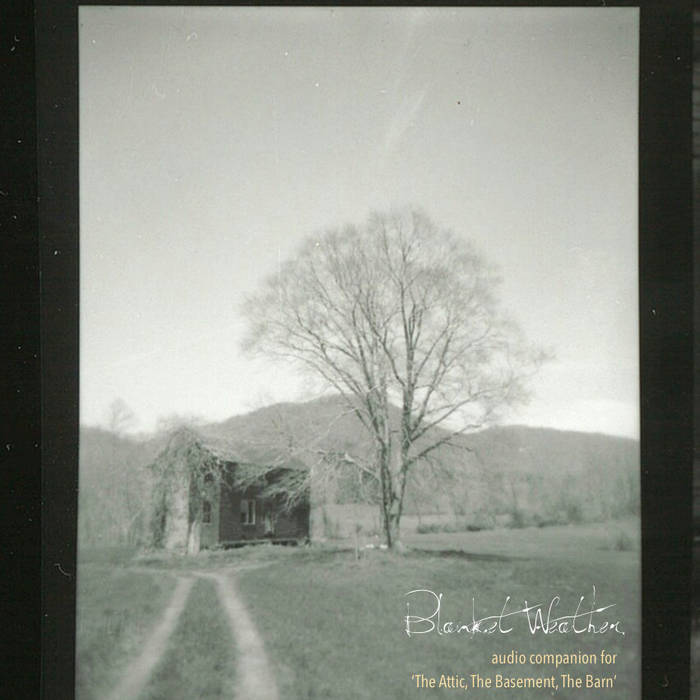
MSL: That’s actually a great segue into my next question, which is just this observation that place has such centrality, I feel, to your work. You just sort of spoke to this—and I have more questions about it later in regards to specific pieces—and it also features heavily in your bio: “Rooted in Monck’s Corner, SC. Raised in Pisgah Forest, NC. Based in Chicago, IL.” So I’m wondering if you could talk more—to the extent that you want to—about the “rooting” and “raising” and what was it like growing up there, and also what brought you here?
SHP: For sure. And putting a verb with each of those locations was also definitely intentional. I think I first had to laugh at it when Google+ profiles were, you know…I don’t want to quite say they were popping off… [laughs]
MSL: [laughs] When it seemed like they might go somewhere?
SHP: Yeah, when everybody was like, “Oh, you need to get on this because it’s going to be the next LinkedIn” or whatever. There was a spot where you could ping on the map the different places you’ve lived, and so I literally wrote out the places. And it was so wild to see all these dots. And I mentioned it in a song, “Metal Moon,” that didn’t make the cut for “Blanket Weather.” I have a line where I say, “Almost a year has come to pass since I U-Hauled my life and I put it in bags.” And that really was the norm for a really long time—after leaving college in 2001, really until coming to Chicago in ‘09—was that, I moved. And Chicago’s the longest city I’ve been in—almost ten years, and bought a house last summer, and have three-year-old twins, so Chicago is home now. But recognizing that each of those places that I’ve sort of fallen in love with or had a heart broken or cared for somebody in—a piece of those places are with me. So it might have been a place I just lived in for three or four months, but you can put in some pretty deep roots in three or four months, if you’re giving your heart to a place. So really carrying Pisgah Forest, which is a forest in North Carolina, with me. You know, it’s special, it’s where I met my wife. I mean, we were 16, and we were friends for a decade before we ever dated. It’s where I made a lot of lifestyle choices that sort of broke me away from a path that most of my other adolescent male friends, in particular, were on, and there was a liberation of sorts that I found when going to the woods, when camping in the woods. And then, just sort of a particular wilderness that I think I still long for and search for that is pretty symbolic and Pisgah Forest really represents for me. And then South Carolina, even though I haven’t lived there since I left for college in ’97, it’s something that always still feels like home when I go back—not necessarily literally “the home” but the quirks, the Southern accents, just everything, there’s so many things. You know, you can hear a cicada up here but when you hear a cicada there you’re like, “Ohhh, right. This is a cicada.” You know, it’s like, “This is a real cicada here. It’s not one of those cicadas that migrated up.”
MSL: [laughs] I love the idea of a “real” cicada.
SHP: “A real cicada.”
MSL: And that also, like, you’re the arbiter of that.
SHP: [laughs] That I can decide which cicada’s keepin’ it real? Yeah, that’s what I do. I decide that if you’re a cicada and you’re frontin’, don’t come through. Don’t post up in my yard. But no, please post up in my yard, because I want our kids to see cicadas, too. So please post up. So I definitely think, whenever I think back to South Carolina, there’s a lot of the same issues that folks in the Great Migration thought that they were escaping, but then when they came to Chicago they found, you know, front and center. I definitely feel like in the last couple years in particular—since having kids, and since a lot of the police brutality and violence has become more covered and spoken about in mainstream journalism—I do find myself wondering like, “What would it have been like to have packed up everything, with your kids, on a train, and you roll up and you’re on the Green Line and it’s loud and this is where you are and you are promised…?”—or, at least, you had the hope of all of these things—and then you get here and it’s like, “Ohhh-key-dokey. Same policies but different accents.” You know? So I’m hoping that with the work I’m exploring now—the current project—that I can really dig into that more so than I had chosen to focus on in the past.
MSL: Yeah. And this seems like maybe a good time for me to ask about what you’re working on now in your next project? Because you’ve alluded to it.
SHP: Sure. So the current poetry project, “The Deacons,” is a series of epistles chronicling the lives of four African-American men who leave a fictive town in the Deep South to come up to Chicago to attend bible college. Each of them are at different stages age-wise, but they’re also in different stages in their faith journeys and that becomes more apparent as their different faiths are tested by living in Chicago. And so it sort of alternates between letters that they’re writing back home to their family and their loved ones and sermons that they’re writing—for class, essentially, because it’s not like any of them are pastors yet, their practice sermons.
And I’m really excited because it feels like the type of project where you could easily over-research it and make it need to become this ethnographic, you know, “1947. Let me figure out exactly what restaurant was on that corner of 63rd Street.” You know, it feels like it could go so deep down those wormholes, those rabbit holes, but I also like that it’s not. I don’t feel that need to make it so rooted in place that I lose the emotions and it kind of becomes calculated and, like, a semi-biographical work. I’m much more interested in the fact that it’s four men, that are each very different. They sort of think they’re the same—because they’re all from this little town, they all go to the same church, and they all are deacons, and they all want to go to school and figure it out—but when they get there and they’re all living together in, you know, a rental room in a motel and stuff, then they start to realize just how different they are and some of the cracks and fissures that even happened back in their hometown that they weren’t really coming to terms with. Because I’m really forcing them to be in a small space together, some of these connections to place are getting teased out in a different way.
MSL: Yeah. And it maybe sounds like an obvious thing to say, but…place is not a constant. It depends so much on, like, the specific person who’s experiencing it–
SHP: Yup. That’s really true.
MSL: –and also who they’re experiencing it with, and of course the point in time. And you said it was set in the 40s?
SHP: Yeah, 1947.
MSL: And even being set in the late 40s versus the early 40s.
SHP: Yeah! Oh, for sure, for sure.
MSL: Can I ask what inspired “The Deacons,” if you know? I know we don’t always know where ideas come from. Or even thinking back on it, are there threads that you can draw?
SHP: I think some of it is from the most recent chapbook—the 2017 chapbook. It feels really weird to say that. From “The Attic, The Basement, The Barn,” I’ve sometimes found myself daydreaming, “I wonder what happened to these characters?” You know, like the ones who were boys in the book. What did they become as they grew up? And then I found myself actually becoming more interested in the grandparents and the great-uncles that I sort of allude to in the poems. Like what happened to them when they were younger? So I found myself wanting to work backwards and think, you know, 70, 80 years before a given poem takes place, what was that granddad as a young adolescent thinking about their career or their calling or their passion or just their get up and work till sunset sort of situation? So I think some of the threads were probably brewing as I was writing but I definitely wasn’t consciously already thinking that that was going to be the next project.
I think where it sort of turned, as always—and I’m sure we’re going to talk about it—is music always plays in. And I found myself listening to more and more country blues. That’s definitely, by far, in my record collection the biggest of the crates—it’s sort of spilled out into another crate—and certain artists who you could tell were rooted in the church but started to play music that was a bit secular, but that still holds some of these call-and-response themes and still has a blues element, through and through, that sort of distinguishes it from a gospel element. I think I just started to wonder about the narratives of those musicians. Maybe they thought they were going to be a pastor and then they were just like, “Actually, I just like playing music here.” So it’s not the God piece, but it’s the connecting with everybody in this place that’s feeling this organ that I’m playing.
And so I think that those were some of the early seeds, just what I was listening to. Washington Phillips was definitely an artist that I found myself being drawn to. He’s sort of this obscure artist who made this instrument that he plays and he did a dozen or so songs and recently some archivists have pulled his collection together and that’s how I found out about it. And he has this song called “The Church Needs Good Deacons.” And I found myself getting drawn to that song, just like, “Huh.” Like, just the way he sings it. It’s kind of like he doesn’t even need you to be listening. He would just be playing because that’s what he needs to do. And I found myself wondering about the secular and the spiritual and what that would have been like on the ebb of the 50s and before– I guess before my education about Black America started, because I wasn’t really taught it until Civil Rights. It’s like slavery and then Civil Rights, and sort of just having to figure out what happened in the middle. So I think all of those were swirling together.
When I was writing my chapbook “The Attic, The Basement, The Barn,” I was listening to a lot of the Alan Lomax recordings that he made in the prisons and on the work farms—a number of his prison recordings of the work songs and the chain gangs and whatnot. And so, again, this doesn’t necessarily show up in “The Deacons,” but it’s that same sort of pondering that I kept going down of what these men’s lives might have been like. Why did they come to the church? What brought them to walk this particular path, to want to devote themselves to faith, to a church? What sorts of experiences in their past may have existed? And I just found myself being drawn to these songs that are so plaintive and are so contemplative and very mournful, but also, because you’re in there for life, chopping wood, there’s definitely some solidarity and some faith to get you through. And I just started to wonder more and more about that and wanted to challenge myself to start to capture it.
MSL: You can answer this or not—and maybe it isn’t relevant—but do you feel like you have a personal relationship with the church? Or it’s more a sort of culture or place-based connection that you have?
SHP: Yeah. I think my relationship with the church is more cultural and place-based. Definitely went to church from, my mom always says proudly, “from the time I was two weeks old in the church nursery,” you know, all the way until I left for college early, at 17. And I definitely, when I went away, it was a conscious choice to not attend any more and, you know, honestly the main thing I missed from church is just that many people who are okay sitting in silence together for a period of time. That’s one of the things I miss so much. And I don’t even mean a Quaker-style sitting in silence, but just being able to hold space together. I don’t really have that in my life and I think about how to situate that for our children’s lives without giving them a particular religious perspective. Because, for me, I look back and it wasn’t so much any particular scripture we were reading, but it was the fact that everybody was holding a book and all reading together. Everybody was connected in this communal activity and it made us part of something bigger than ourselves and kind of connected us to the millions of people before and the millions of people after who are going to sit in that same seat—or in that same space, holding that same space. Which is, again, why music, particularly with the blues, why that tradition resonates so much with me. I have a line in one of my songs where I say, “Take three small chords, build twelve tall bars” (“Iron Cast Blues”). You know, you just need three chords and anybody can at least start to engage with it as a tradition. I’ve never really compared blues and church, personally, for me, so that was actually neat to hear that even coming out loud. [laughs] It’s a fine line, maybe. Now I’ve realized.
Video of “S/KIN FOLK: An evening of poetry, recipes, essays, & raps”—a celebration for the release of Saleem Hue Penny’s chapbook “The Attic, The Basement, The Barn” and its audio companion “Blanket Weather.” The screenshot shows the author addressing the audience (seated behind the camera), with a wall of books and a “Build Coffee” sign behind him. He wears a t-shirt with Jenny Schrider’s illustration (see below) patterned across the front.
MSL: Going back to the research thing for a minute, you mentioned the role that you anticipate research may play—but also where you want to draw the line—in writing “The Deacons.” And I’d love to hear you talk about it also in relation to “The Attic, The Basement, The Barn”? Something I really love about your poetry is, I feel like it’s both very quote-unquote “readable”—like, there’s a story to it, that you can follow—but there’s also a density to it. It’s dense with references but not in a way that disrupts the storytelling. So I feel like there’s something that I maybe get out of it, but if I knew a lot more about, like, flora and fauna and landforms and weather of a particular place—or even if I knew the Latin names of things—that I might get a lot more out of it. I feel like it permeates a lot of the work in different ways. Oh, constellations, too!
SHP: Yeah. And meteor showers.
MSL: Yeah! But I guess just hearing more about where that comes from, how much research goes into your process, and what you hope the reader or different readers get out of that?
SHP: No, that’s great. One of the things I’m proud of with “The Attic, The Basement, The Barn” is that it never felt over-researched. You know, I never had more than two tabs open and usually those tabs were open because I didn’t know how to spell something. Or I wanted to make sure that the way I remembered a plant that I saw when I was 16, I wanted to actually remember, you know–
MSL: “Did it have that many leaves?”
SHP: Yeah! Precisely. It literally was those things. Of like, “Was that actually a fern or was that a flowering shrub?” Like, I remember it and I remember what it was called, or I definitely remember what it tasted like, but I don’t know if that’s actually a taste it had. And sort of letting the research not always necessarily win, because there were times where I was like, “Mmmmm…. Okay, maybe that’s what it was but that’s not how I remembered it.” So I’m going to write how I remembered it. I do think that—as far as the density and what I would hope that would accomplish—the goal first and foremost for me always is that it’s accessible. I don’t want anybody to ever pick up one of my poems and feel dumb. I don’t want anybody to ever pick one up and be like, “Crap, I don’t know what any of those words mean. This is why I hate poetry, because it’s not written for people like me.” I don’t ever want that to happen. If that happens, I’ve failed on a number of levels, you know?
MSL: And that’s so much of what kept me from poetry for so long. Just feeling like I didn’t have an access point.
SHP: It still keeps me from some poetry. Like, “I’m not smart enough to understand this.” And that’s an awful feeling to leave a reader with. So, to find a balance where somebody can still feel a little challenged—like, “Huh, I wouldn’t have thought to use that word”—but also not that they have to keep a thesaurus and Webster’s pulled up next to them for an entire poem. As far as what I would like people to take from that is, I hope it would push them a little bit to be like, “Oh, that’s interesting they used the Latin names. Huh, I wonder what the Latin name for– Oh, let me just look up the Latin name for this other thing!” And just see what it is! It’s not like, at some point, I would have just had the Latin name and left out the common name. That’s not the point. The point is that I used to be so intimately connected to some of those plants that I knew the Latin names. All the ones in here where I reference Latin names, those are all plants that I still remember the Latin names of. You know, from age 16, 17, 18. I didn’t have to go and research to be like, “What is the Latin name for dandelion?” Because, thankfully, I learned that in ‘96 and it’s 2018 right now and I still remember that. That’s pretty awesome. Like, shout-out to that teacher. [Marya laughs] Shout-out to Ted Wesemann at the Outdoor Academy of the Southern Appalachians! You know, for making sure that these plants and these birdsongs and these constellations—that these were real things that I made a meaningful connection with.
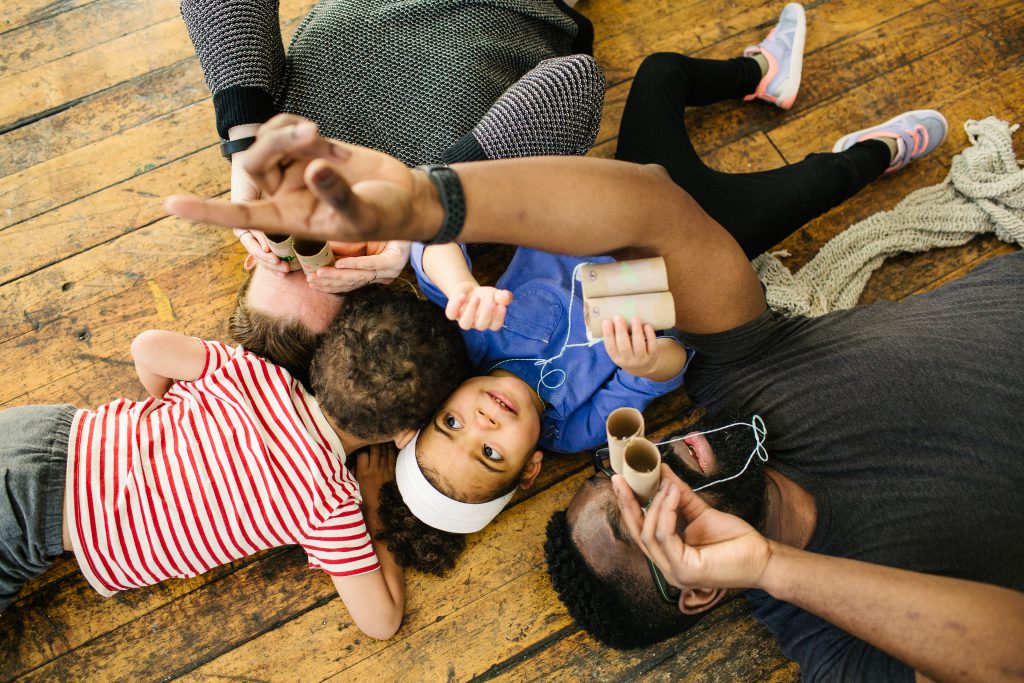
And especially now that I’m in a city where I can’t actually see the stars—and where, if I see a dandelion, I definitely can’t pick it and eat it because it’s probably been sprayed and treated with whatever was on the lawn—it’s even more important to capture some of that and hopefully encourage younger people to interface with it and start to wonder, start to ask those questions about the natural world—that’s very near us, and all around us, but unfortunately humans have become pretty good at busting it down and paving over it and sort of erasing it from their day-to-day presence. Oh, but another piece you said, if maybe you knew more about a specific type of flora or fauna or constellation, etc.? I’d like to think that if somebody knew a little more maybe, not even that they would “get” it deeper, but that they would just appreciate that decision a little bit more? But I don’t want it to be this VIP thing, like, “Oh, you definitely understand the life cycle of a salamander, so you’re definitely going to get this little reference I’m about to slip in.” But I would like the person who really knows their herbology or something to be like, “That’s interesting that he happened to pick that, and that was accurate, and huh! Okay, good stuff, let’s keep it moving.”
It’s been frustrating, at times, having to find this information out for myself—particularly frustrating as an African-American—not always having the direct link to that in my day-to-day. In spite of the fact of coming from that tradition of people that worked the land, taught other cultures how to use the land, you know, were tied to the land, were stripped of the land, figured out how to reclaim the land. You know, in spite of that, that it can still feel completely foreign. I do feel proud of those times when folks have made space that I could experience the land. Because it’s definitely not guaranteed that we get to run our hands through a garden, or through soil, or see a tomato before it’s shrink-wrapped. And those are all experiences I’ve had, and gotten to have.
MSL: Yeah. I’d love to talk more about the land and the work’s relation to the natural world, and maybe first pause to hear a bit about the work we’re talking about. So, a few months ago, you released this beautiful chapbook–
SHP: Thank you.
MSL: –“The Attic, The Basement, The Barn,” and its– Are you calling the album the “audio companion”? An “album”?
SHP: Yeah. I’m calling it an “audio companion.”
MSL: –the audio companion, “Blanket Weather”—both through Tammy Journal Chapbooks. And I guess I’d just love to hear about that project! And where that project or those projects came from? If you’ve created chapbooks, albums, audio companions, previously or previously together? How was this process different? I guess just giving us some grounding for the pieces.
SHP: Yeah. So it’s, first of all, definitely surreal to even be sitting here with a chapbook sitting in front of me that has my words in it. And I hope I never lose that sense of awe, you know? Before even talking about the process, I think part of what is really special is when you can have a publisher and editors and a press who, you know, support an author. The week that I got an offer to have the book published I actually got—the same week—offers from two different presses. And every time I think about it I’m so glad that I ended up accepting to work with Tammy. The other press I would have gotten money. There was a ton of, you know, like a contract that was multiple pages and like, “You’ll get this percentage per unit.” And it was just like, “Wow, a unit. I’m not sure if I’m ready to sell units.” You know? I want this book to be in people’s hands, and I want people to be able to engage with it, and to hopefully come away with some more beauty in their life. And to be able to work with people who are all themselves authors is a huge piece, and that they’re able to listen to the suggestions I had, to incorporate some of the direct artistic feedback, but then also for them to be able to hold strong with a particular vision they had for how the four chapbooks in the series were all going to hang together, and how they were all going to be designed and laid out, and I really respect that. They clearly had a vision, too, and I think we were able to find ways that those visions could be complementary. And just to be able to see that support extend into the release celebration that I did, with them covering the rental cost of Build Coffee where we held it. So it is small things like that that, although dollars don’t come pouring in off of a poetry chapbook, you know–
MSL: [laughs] Regardless of where you publish it.
SHP: Regardless of where it’s going, I’d still prefer to have folks in my corner who I know are going to make that other print run for me if there’s enough people who are saying that they want that, or are going to trust that if I say we should stock it in x, y, and z store they’re going to reach out to that stockist and give it a try, that they’re going to trust the author through the process. I think that’s really important. Because I think this conversation would have probably been totally different if I had gone with a more corporate or more traditional publisher at this stage in my writing. But for where I am, with my first time having my work published, I couldn’t have asked for a better publishing relationship.
As far as where this fits in the chronology of things, I’ve definitely recorded complete albums before—again, under the h.u.e., “hope uplifts everything,” moniker.
MSL: And those are on SoundCloud? Or various places in the world?
SHP: Various places. Some of them are on my Bandcamp page and a lot of them was before Bandcamp and SoundCloud.
MSL: Myspace?!
SHP: Yup! Yup, I had three tracks up on Myspace forever. It’s funny, they’re actually still there. But I do remember just burning CDs, giving them to people, handwriting the titles of the songs on it and, you know, passing them out to friends as gifts. So, I never really—partially because I didn’t trust my art to stand on its own enough to try to sell it, that imposter syndrome, you know, as a musician. Because I can’t play any one instrument, but thankfully, with technology and sampling and looping and stuff, I’m able to create pieces that I couldn’t if I had to rely on traditional instrumentation. So I think with some of that imposter syndrome, definitely not ever jumping in enough to just say like, “Hey, can you put this in the ‘local’ section of the music store?” I’m sure there probably would have people who might have, but I just didn’t feel competent enough to really do it. And so most things just released either to friends and family or just available for download.
My first album was ‘01, and that was done with my friend Jon Reid, who recorded under the moniker “jar-e.” Of course, you come out the gate big, so we came out with a double CD. You know? [laughs] Why start with ten tracks when you can start with twenty-two? Or however many we cranked over the course of a whole summer on an analogue four-track recorder, and then mixed down onto CD and then burned on an external CD drive. So there was never a computer involved in anything. We didn’t even have a computer. It was all tape to direct CD to Sharpie to a jewel-case. And so, I do think that urgency starting off and that sort of hustle spirit but not hustling to make dollars—hustling to get it to people, because we believed so strongly.
The album after it was “Transitions and Transformations.” It was my first time living on my own, right after college—well, I wasn’t on my own, I was actually a live-in nanny, but I was not in college and I was not at my mom’s house, so that’s what I mean by living on my own. That was a really important album to me. And then “The Hyper-Mellow Me” was another album that was done a year or two later—going through a pretty transitional space, just “what do I want to be when I grow up?” sort of thing. You know, you’re 22 and that pressure of—it may be different for different generations—but like, “I should probably have my life more put together by this point.” Looking back on it at this point, that’s sort of silly and absurd to say, but at the time that’s what it felt like. And I think some of that’s cultural, that pressure of, it’s a privilege to go to college—you know, from a working-class, single-parent home—and to not have the whole plan laid out and already coming to fruition in a way felt like idleness. So I feel like I captured some particular emotions during that time. And then everything else, pretty much from ’02 through ’05, was just small little singles and little collaborations. And, again, that was still before SoundCloud sort of opened up new doors.
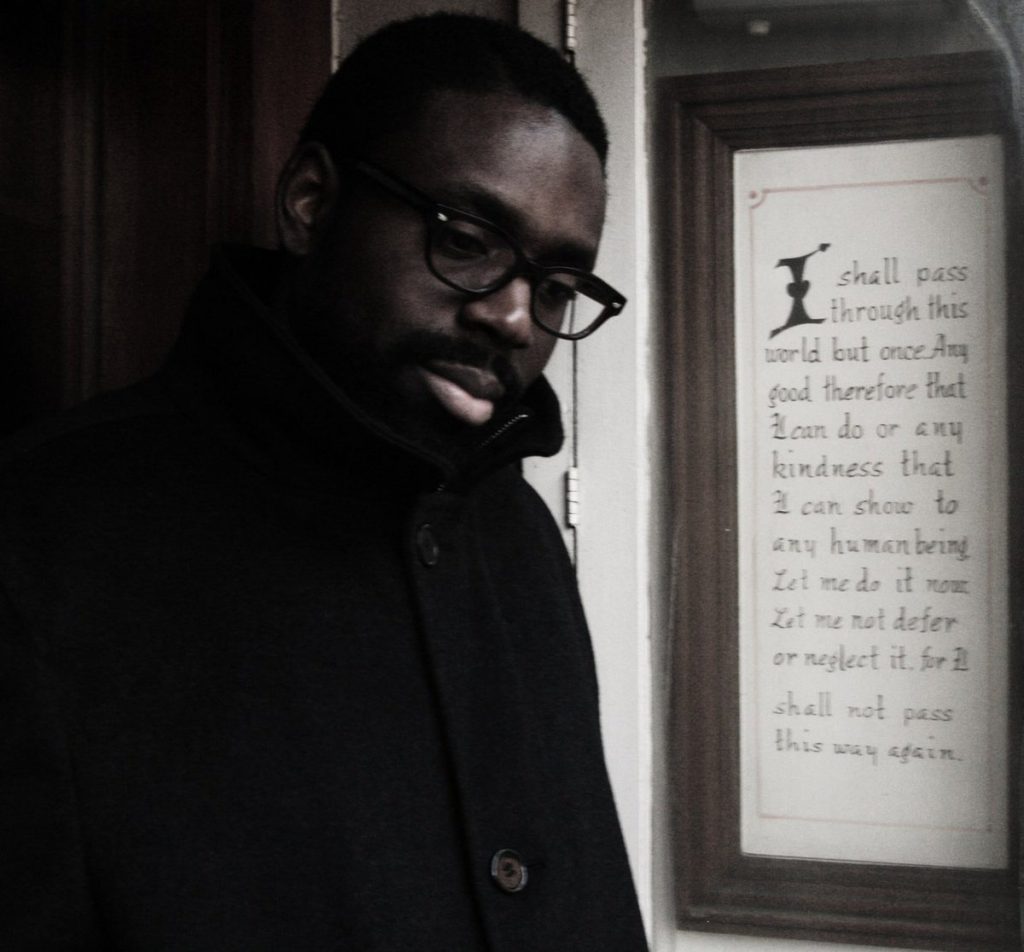
And then the album that I think the most people have heard, just from my Bandcamp, is called “Starfish Time,” and that was a very cohesive album. It’s just a very special album because it’s so rooted in place. That’s when I was living on a farm. It was an in-patient residential mental health facility and I was on the staff there and so that was my escape, you know, the headphones and the microphone from such high-stress residential work. But it was also such an opening point, because so many of the adults who were there were artists of some sort, and that history of creativity coming from unconventional sources and how it helped me really speak a language with a lot of adults there, through music, who weren’t being engaged in other forms. That album definitely has a lot of importance to me. Lost a close person to suicide that same year, lost my granddad, lost an uncle. So a lot of things are really in “Starfish Time.” And it’s called that just because that’s what I wanted at the time, was, you know, to have these limbs grow back that I had lost and to be able to measure time not with a clock but with loss and regrowth and to move at my own pace. And that tension, because that’s not really how time works. It just ticks forward, regardless of how many people you lose in a period of time. So “Starfish Time” was a powerful one.
And unfortunately I just stopped recording music. It was a really hard choice, and I don’t think it was a good choice, but when I started grad school I just had this idea, “I’m going to be a grad student, I’m gonna rock this, I’m gonna get these incredible grades and all these scholarships and I’m going to leave all my recording stuff and I’m going to pack it up and I’m not going to bring it with me.” And that was a painful thing to do for my soul and my spirit.
MSL: And this was when you came to Chicago, or when you went to Michigan?
SHP: This is in 2005, when I went to D.C. and prepped for going to Michigan. So it continued. ‘05, two years of grad school. Didn’t learn my lesson, for whatever reason. ‘07, continued through grad school. Until ‘09, when I came to Chicago. And in ‘09, I was like, “That’s part of the problem, why these last four years have been so far away from myself.” Because I didn’t have these inputs and these outputs. So kind of making the decision around then to really start to dive back in. And it’s funny how music still would creep in, you know? There were still collaborations. At my chapbook celebration, the first song I did, I told the anecdote about a guy that I met in a dairy barn and he had an instrumental CD and I had one of my albums and we just swapped. And I ended up writing for a full year, off and on, to his instrumentals and ended up recording them and, you know, have never been able to share them with him because I can’t find him. And it’s not like we had business cards on us and a bunch of social media links. It was just like, “This is great, this is my name,” “Oh, this is my name,” “Cool.”
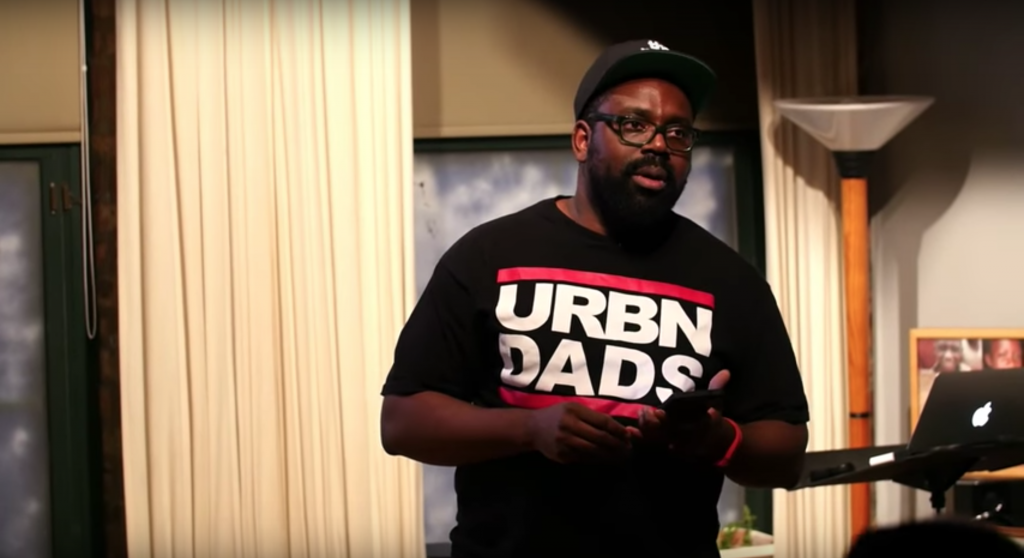
MSL: Are those songs on “Blanket Weather”? Or those are other songs?
SHP: No. Those are other songs, that are on a project called “The Summer Sessions.” I wanted to make sure he had the credit, so it’s “Boy Plus Rocket,” which is the moniker he records under, or used to record under, and h.u.e. So yeah, all I’ve talked about so far, some of that has laid the groundwork for “Blanket Weather,” but a lot of the songs on “Blanket Weather” were the ones that never made it on any of those previous albums. They’re pieces that I had done off to the side, or are spoken word stuff from a journal entry that I ended up putting to music, or just hadn’t been on an album.
I was going through my phone a couple nights ago thinking about this conversation and I pulled up the original tracklist for “Blanket Weather.” And it’s really interesting to see the original tracklist versus the tracklist now, and to see how there are some that never changed, and that were so core, but the order of them and the presentation, that didn’t fully take shape until the chapbook was nearing completion. And the tone of the chapbook really mirrors the order and the tone of the songs. It’s not to be designed to listen to as you read it—because they’re not one for one, by any means—but it is interesting to see—because the chapbook was basically a two- or three-year process—how I thought the music was going to go in a particular direction, but then the poems ended up informing it. And then honestly, vice versa. There were times when I think a poem might have just stopped but a song sort of picked it up or let me extend an image or extend a tone a bit further in the written work. So it is really neat how they ended up really complementing each other. That’s why I call it a “companion.” Even though they are really different voices. Like my song voice, it’s almost always first-person. And the poetry, I think it can alternate between third, quite a bit more, but for songs– Oh, I think one of the songs is “he” and “she,” but basically the other songs are “I.” Because, for the most part, it’s a lot more vulnerable. Or, I’ve had a lot more experience being vulnerable when there’s music involved, is a better way to say it. So that’s sort of the genesis of “Blanket Weather.” I knew that title from the very beginning, because it’s from a line in one of the poems.
MSL: I was going to ask! Yeah. There’s a lot of symmetries.
SHP: Yeah. It’s a poem where it’s two figures—two lovers, two somebodies, two people in a relationship; it’s not exactly clear—and he says– I can just read it. I know the line.
MSL: Is it “All The Heat I Have”?
SHP: Yeah, it is in “All The Heat I Have.” Here it is. “You tremble slightly / and I breathe into you all the heat I have, / for blanket weather will soon be upon us.” So “All The Heat I Have,” I loved to have the title line of two things back-to-back. It was kind of an inside chuckle to me of like, “Nice! Title of a poem, title of the audio companion, right next to each other. That’s a couplet.” So yeah, “Blanket Weather.” So, of course, after making the original tracklist, I made a version—if the dream, which is to have it on vinyl, because why not?—of what the songs would be there. And it’s really neat, because I had to think about it differently. Because if I could get thirteen minutes per side, you know, on a 10-inch—it sort of helped me condense it. So it would have to be eleven songs. So that was part of the whittling down from the original. But it’s still interesting, even then, to look at how the last song on this version ended up being the very first song on the album, because of the poetry—I changed it—and so the first poem ended up being very urgent and opening up directly in the middle of a line. Whereas, in earlier drafts, the first poem kind of rolled and slowly ramped up and then you eventually got into the action. So it is interesting to see how the songs in some ways—their order and their urgency and their tone—were sort of changing, in flux, as the poems were changing, but I wasn’t all that aware of it until it was all done.
MSL: So, with what you just said, did you mean that—because “Sunset, Before” opens the chapbook—that the poem used to be different such that it didn’t hit right away? Not that there used to be a different poem there.
SHP: No, it didn’t hit right away at all. Yeah.
MSL: I love that poem.
SHP: Thank you.
MSL: And I do remember that there were different versions at some point, though this is so the one that’s in my mind now. And is that the poem that got nominated for a Pushcart Prize?
SHP: Yeah. Yeah. Thank you.
MSL: At what point did you realize or decide that these things went together? And even just to hear more about that concurrent editing process. Were you writing them around the same time? Had you written some of them before and just re-discovered them? Yeah, how did all of those things come together to be what’s sitting in front of us?
SHP: Sure. Perfect. So, as far as the process of editing them together, I usually did not listen to the songs as I was writing, because it’s weird to be writing while you’re also listening to your own voice, in a very different medium, with a different rhythm. And my songs almost always rhyme, and none of the poems in this chapbook rhyme, so it was just too discordant to be doing it at the same time. I wrote a lot of the book when our twins were infants, so I’d be up for, like, the 2 a.m. feeding and I would have each of them in a cradle and I would have each foot sort of rocking them back and forth and just writing on the laptop in the middle. And so I would have on headphones pretty often.
And one of the things that I did enjoy doing was listening to one of the “Blanket Weather” songs either at the beginning or at the end of a writing session. And I think another role that “Blanket Weather” held for me is, I kind of got into a slump with submissions at one point, where I felt like I didn’t want to change the chapbook. I worked with a great developmental editor and really had it in a nice place. Kat Don was super supportive and also tried to push me to think about unconventional forms. Because my earliest draft that I turned in to Kat, I had the lyrics to the songs and the actual poems all sort of together.
MSL: [gasps] That’s right!
SHP: Yeah. And they all sort of alternated. So it would be like a poem, song, song, song, poem. Poem, poem, poem, song, song. And it was pretty unwieldy. And then I did a version where I just took out specific lines from the songs and maybe a couplet or a chorus would be on a page. So I scaled it back from there, and then decided that the two were going to be completely different, completely separate. And I think ultimately that was a great choice. But I do know that—during this time, when I was kind of in this slump—at one point I was like, “Just go ahead. You know what it is, you know the cover art, you know the font, you can already picture what “Blanket Weather” is…. It’s done. Just put it up on Bandcamp, and just have it be there. Go ahead and say it’s going to be the audio companion for this book when you don’t even know when it’s going to be published and just speak it.” And so for like a year, it was just up there. And it was like, “Audio companion to ‘The Attic, The Basement, The Barn’!” It was like, “Whaat? Where is ‘The Attic, The Basement, The Barn’?”
MSL: “Forthcoming”!
SHP: Yeah! Exactly. It was “forthcoming” in 2016 and then it forth-camed in 2017. Not that that’s a word. So I do think that “Blanket Weather” ended up playing an interesting role in my process. Not that I would have given up on it, by any means, but at times when I felt like I was in that slump it was like, “Well, you’ve already promised it to the world. The audio companion’s already there.” And randomly somebody would click and be like, “Oh, what’s this a companion to?” Which is always cool, when a stranger finds your music in general. But then to be like, “Oh, it’s for this thing that I’m writing that maybe it will–” No. “It’s for this chapbook, that’s going to come out. Go to my website. Here’s a description of it. Even though I still don’t know how it’s all coming together, but I still know it is this thing and there are the core poems that I want to be in it and the rest is sort of up to the mercy of editors and people who happen to want to put it on paper.
All of the songs had been recorded prior to 2012, when I started digging in on the book. Or, when I had my earliest sort of glimpses of what the book might be. I hadn’t seriously started writing it yet, but I at least had ideas.
MSL: Well, it’s so interesting after seeing or hearing different versions of the poems, particularly, over the last few years. And it feels so rewarding to me to read them all together in the same place. Not only because they reward re-reading, but also because re-reading them in the book form, I noticed resonances or echoes between poems that I didn’t before—and surely they’ve also changed over time—but also, I didn’t necessarily sit and read them all at the same time. I might have read one one year, one another year; read one when you published one. And not just noticing themes, but specific words or events or characters that I started to connect across poems and songs—like little ecosystems or constellations of their own. It raised a lot more questions for me and I was doing a little, like, “Does Saleem have this grand unified theory of these things in relation to each other?” There are a couple I can call out specifically. There’s a line in “Youth Electric,” the poem, “Me, in line getting quarters at the laundromat,” and then in “In Time,” there’s the line, “it was my turn to get quarters but / somebody got shot at the laundromat.”
SHP: Yup.
MSL: And it was so interesting seeing those two together, in part because, when I read each poem separately, I read the setting differently.
SHP: Yeah, yeah! Oh, that’s awesome. Oh, I’m really happy to hear that.
MSL: But then I noticed that, when reading them near each other in the same book, I was like, “Wait! But I thought that this one was Chicago or some Northern city, and I thought that this one was North Carolina or South Carolina, and is this all in the same place? How am I reading place into the work?”
SHP: Yeah. Right, right.
MSL: And the switchbacks in “Laying Down Tracks 1” and in–
SHP: “Bringing Home the Weather.”
MSL: “Are those the same switchbacks? Is this all in the same place? Is this at the same point in time?” There’s “falling into the Green River and being nursed by a friend” in “to be continued” (the song), but then something similar happens with similar words in “In Time” (the poem). Anyway, I would just love to hear you talk about the places where the stories and the images and the themes—and even the intonation or cadence of things—mirrors or threads through.
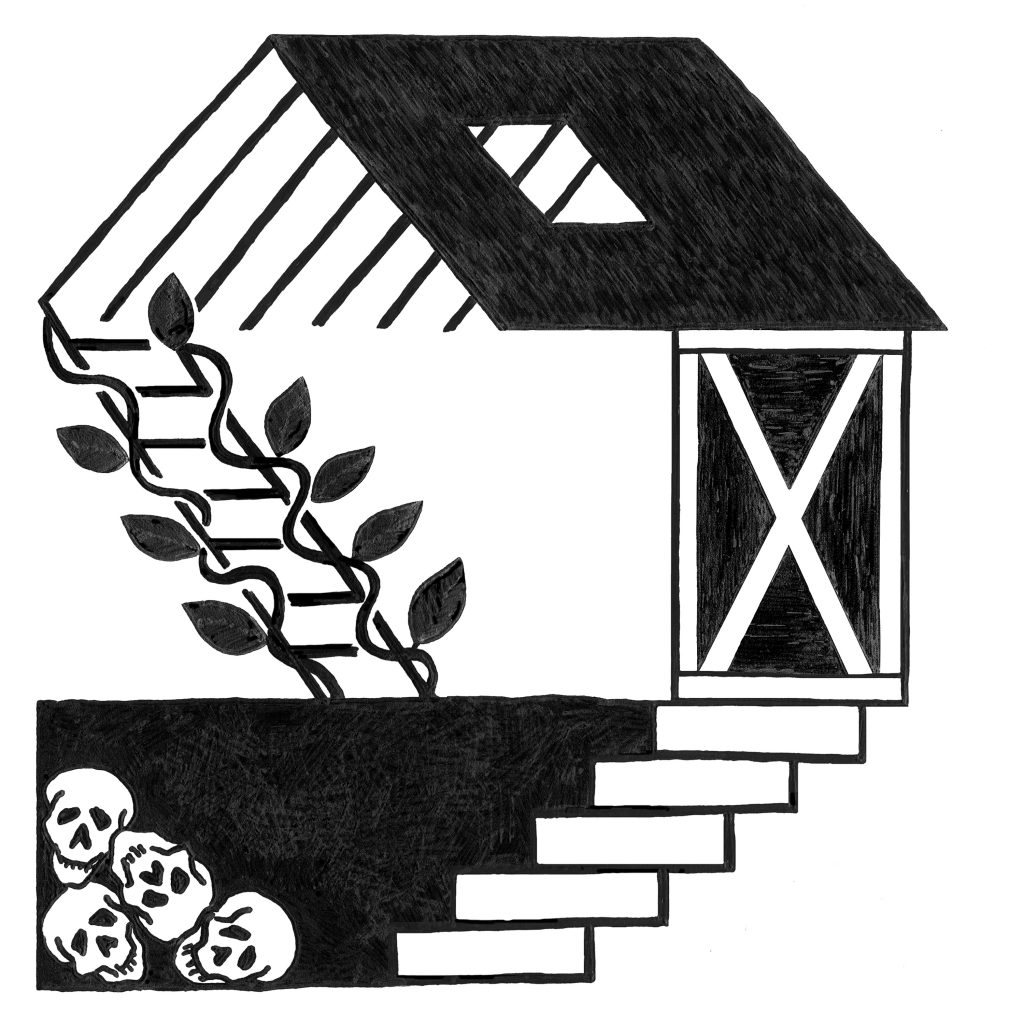
SHP: Yeah. So it was really fun to have the laundromat reference happen. I love that it happened between two poems and between different ages of people. Right? Because I did like the idea, that I had for quite some time, of having all of the poems either take place in a world of, like, horse-drawn carriages—you know, that time period, which I recognize is weird to say, like, “the time period of horse-drawn carriages”—or the time period of subways. For me, those are extremes, but they’re two ways of moving around.
That’s why I mention moving through space and time. So do I want things to happen in a place that has the pace of, you get a letter or where you get a phone call or you get an email or a text, or you get a vapor cigarette or you get a letter? That was really interesting to me, and I feel like it sort of worked itself out as I went through the pieces. This idea that the boys from “Easter Sunday,” who were throwing the rocks outside behind the gas station, that it’s possible they could be the same boys during “In Time” who are running around the library getting in trouble. And they could be the same boys who are reminiscing on their childhood but are in this stuffy networking reception. And it’s possible they could even be the same boys who lived in the time period in the same city block as this laundromat—you know, that got shot. So I kind of liked that, if I gave myself the freedom to have these characters sort of move through space and time, it did open up a lot of possibilities. That I could tip to, these are all happening in some sort of continuum in perhaps at least the same city. But not, like, this is in ‘96 and this person is 2003. Or they could somehow be at least within the same generation, and that would be enough for me. Or one to two generations removed.
I did like the idea of, whenever the kids are back in the South—and they’re sort of in the land of skipping rocks and pants rolled up to their knees and that sort of thing—that they are a bit different from the ones who are skateboarding in the abandoned cul-de-sac and lighting mailboxes on fire, you know, to pass the time. But I still wanted it to speak to that same sort of restlessness of youth. Of just like, “Oh, they’re throwing rocks at squirrels and they’re feeding an old bird French fries.” It’s still the same screwing around with nature, with pesky animals, with your crew, and just whatever happens in your day happens in your day. Because sometimes that’s how simple it is. That’s part of the reason I wanted to make sure this book could get in the hands of young adults. Because they have their own stories of navigating wild places and of reckoning with their own freedom and their own boundaries as they move through space. That was a really important reason why I wanted to have another organization—ConTextos—be part of the release celebration, that it wasn’t just me sharing my words but to really try to amplify the voices of other young adults who are authors and are doing this work.
I do feel that that was one of the things that came off exactly as I had envisioned, that the characters move between space and that it let the reader sort of catch themselves and be like, “Wait, which poem am I reading?” Because that’s the beauty of a chapbook. You could sit down in one sitting and go through it and get transported between, “Wait, was it eight poems? Or maybe there were only five, if those were happening in the same place? That could have been the same character….” I wanted people to be able to do that and not prescribe it like, “This is Chris. This is the same Chris you read about in poem #2.” I didn’t want it to be that prescribed. I think that the most clear reference was the Green River reference, during “to be continued” (on “Blanket Weather”) and “In Time,” of the young man falling out of his canoe into the Green River and getting hypothermia. And, that did happen to me, around that age. Well, it happened twice actually, but not at the Green River. So it could have been either of those unfortunate hypothermia times. [laughs]
MSL: [laughs] More collapsings and bridgings of space and time.
SHP: Yeah! I know. “Ohhh, this happened twice on rivers in North Carolina. From canoes.”
MSL: “And I had something to do with it.”
SHP: “And I was involved both times.” Which is the common element in that, unfortunately. So I do think that that was the most obvious example from the music. If I had to draw a line, like, this song “matches” this poem, I couldn’t do that, but I could say, “This song really supports this poem,” or “This poem really supports the tone of the song.” Like the audio companion starts off with the song 1st Time Again, and that is about two lovers who are essentially saying goodbye, in the same way that the chapbook starts off with “Sunset, Before.” Again, totally different, very different. The song is much more in the 21st century. Whereas “Sunset, Before” could be any variety of eras where the Klan or other groups could have– Actually, that’s really sad to say that. It’s 2018. So that poem still could happen. Yeah. That one isn’t so rooted in the past as I’d like to think it is, actually, now that I’m saying this out loud. But I do think there are a number of times where I could pin a song and a poem that, hopefully, each brought a different light to the other, even though they were recorded and/or written at very different times.
MSL: And I think that there’s something in the feeling or spirit of the songs and the poems that is…. I mean, the phrase that’s coming to me is like, the permanence of impermanence?
SHP: Yeah. Yeah.
MSL: Like, impermanence as a permanent condition? And I think it’s there in different ways. There’s sort of cyclical time or relative time, which we see in some of the songs, with the “passerby” and the “static observer” and these different shifting positions. And with things like what you were just saying. Or like with the example I gave earlier, where I was reading place in very particular ways on my first read-through—or when reading things separately—but when reading them together was like, “Oh. These actually maybe co-exist in a closer universe than I thought.”
SHP: Right, right.
MSL: Right? But then also this aspect of, like, generational time? And the idea that the more things change the more they stay the same, but also, what are the small changes that happen across that time? I feel like it’s a theme that is in multiple pieces across these and it’s amplified through that feeling of…I always feel like I’m in a specific time or place when I read these, but then I’m also very conscious that I’m…
SHP: Not.
MSL: That I could actually be in multiple.
SHP: Yeah! Yeahyeahyeah.
MSL: It doesn’t feel vague. It feels very specific. I just don’t know.
SHP: Right! Yeah. It’s funny, because you made me think of another one. When I thought of the cover art of “Blanket Weather”—that old farmhouse—that’s how I envisioned the farmhouse in “All the Heat I Have.” Because, again, I was like, “Ooh, can I do a “Blanket Weather” tie-in of the line from ‘All the Heat I Have’ and a photo tie-in to ‘All the Heat I Have’.” I forgot that that was definitely a nod to that poem, both by the title and by the cover art.
MSL: And speaking of different kinds of layers, I’m interviewing you in your beautiful office at Chicago Children’s Museum. How does your work with, and for, and promoting work by youth, connect with your creative work? Do you see them as the same thing? As spokes informing each other? Something else?
SHP: Yeah. So I was a chemistry major in undergrad. And I never wanted to be a chemist but I did want to be a middle-school science teacher. And I wrote a whole song actually, where I wanted to use chemistry metaphors—oh god, this is so funny, I haven’t thought about this in forever—to describe, like, a break-up. Or being right on the edge of a break-up. But within the song, I have a line where I’m talking about the triple point—and it being that point where a liquid, a solid, and a gas can all coexist, and you have to have a very specific set of pressure and everything for it to happen, but there is this one point where you can have all three of them and that can happen at the same time.
I do love when I have those, like, triple-point moments where my personal artwork, my professional museum hat, and then my community volunteer hats—when those three hats, when those three roles—align. Like, it’s magic. You know? And so the time most recently when that happened was when chatting with ConTextos—actually, at one of the conversations about planning my chapbook celebration—and we started talking about the father engagement work that I’m doing at the Chicago Children’s Museum, particularly with low-income African-American and Latino fathers. And it was this great light bulb moment for them because they’re like, “We’re doing this incredible work with the adults and getting them empowered as authors and having them be able to critically read texts and create their own autobiographies, and a lot of these men are fathers and have children and what are we doing around children’s literacy? Or around helping them amplify the stories of their children. Or having them share their newfound or newly created passion for poetry with their children.” And it was just this awesome moment where I was like, “We can do, like, a ConTextos junior.” I mean, I didn’t say that—that’s kinda cheesy—but, you know, immediately we were just like, “Yup!” Like we could have the authors come and read their poems with their kids, and their kids could create writings and art and look up to Dad as an artist, and the dads could get to think of themselves as role models in this super creative space and feel welcome and comfortable here.
So it was this great moment of all of those roles coming together—my role in the museum, as Director of Community and Educational Partnerships; role as an artist; and then role as a community-builder and as a father. I think that they’re separate only to the degree that I can’t just stop for an hour during my workday and write poetry. So, anyway, I’d say the different roles do line up quite well. And also the volunteering hat—because I volunteer at Comer Children’s Hospital doing bedside magic with Open Heart Magic. That piece is still about healing, it’s still about art, it’s still about empowering caregivers and parents, and giving them a break and helping them get to be young and feel like a kid again for that twenty minutes that I’m in their room, getting them laughing, making a card appear. It’s the same as when they’re here at the museum—you know, for that hour that they’re here on a field trip, to have them not just on the phone checked out but to have them playing and pretend-shopping and cooking in the pretend kitchen. It comes from the same place of wanting parents and caregivers to have the permission and the support to play, you know? And to be free. Because otherwise the cycles just continue, of childhood being something to hurry up and get through, and that’s not how I want childhood to be for people. I really don’t.

MSL: As we close out, whose work do you find yourself turning to these days, and for what? Or what kinds of work?
SHP: Yeah. So I was in the Seminary Co-op on Sunday and one of our kids was asleep in the stroller so I got to say, “Hey, I gotta leave, this café is too loud, I’m gonna go walk her in the poetry section.” It was perfect. I haven’t done that in months. I forgot how much I just missed being in a bookstore and being quiet in a bookstore. I mean, it is fun when we take our kids to a bookstore, just because they love books, and it’s such a special feeling when they see an author or an illustrator and they know that illustrator. It does feel like, “Okay, we’ve done something right.” But it was still nice to have that quiet. And it’s so overwhelming to stand in front of a shelf and know that even if I had all the hours in the world I still could never get through these poets.
MSL: Mmm hmm. It’s like the blessing and the curse of a bookstore.
SHP: Right!
MSL: You just feel so small.
SHP: Yeah, exactly. I’m just talking the contemporary folks. I’m not even talking the canon before us, but I’m saying just looking at the folks during my lifetime and to know that I cannot get through those collections. So then what does that mean for who you select and who you surround yourself with? Especially being a newer parent, with toddlers, when the time is so limited. The pressure, I feel, is even more there. Where do you snatch those 15-minute windows, and who do you choose to fill that up with?
And I feel like, for me, I want to make sure that there’s always a blend of writers who are from the place I’m living—so, obviously in this case, Chicago—and then also making sure that I’m reading writers who are going to make me step my game up. It’s awesome when it happens to be the same, and I’m very fortunate that a lot of the people who I feel like I have read recently in Chicago have also made me want to step up my game. So I think some of the books and authors who definitely stand out—Cortney Lamar Charleston has several pieces I’ve read where I’m just like, “Oh. Man. Gotta step my game up. How am I going to do this?” Or any time I pick up “Wild Hundreds” by Nate Marshall, I want to go to each of those street corners and just like, see it through his eye, but since I know I never can the page will have to do. Eve Ewing is deservedly at the top of so many of those best-of lists. I haven’t even finished “Electric Arches” because I keep giving away copies! And then to read people who have been doing this longer than I’ve been alive, or longer than I’ve been in this, I feel is important.
And I think it’s important as a Black male to also find those voices. Especially because I’m not growing up with a father, it’s that constant search for, “What does it mean? What does manhood mean? What does fatherhood mean?” and to just find those folks. And it’s really special when you can. Like I reached out to Ishion Hutchinson and asked him if I could send a copy of my book to him and did and it was so cool that he emailed back and was like, “I received it today. It’s lovely. I look forward to reading it.” Or A. Van Jordan is another poet who I’ve always looked up to. And, similarly, I asked it I could send him a copy and he’s like, “Oh, I actually just bought it this week.” And I was like, “Oh, maaan….”
MSL: Oh my God!
SHP: Like, can I please have that quote framed and put up?
MSL: You should add that to your chapbook website where it’s like, the reviews, and his just says, “I just bought it.”
SHP: Oh! Oh, I should totally do that. “A. Van Jordan: ‘I just bought it.’” And that’s the quote. “‘I just bought it last week.’” And one other thing that has sort of happened accidentally is, I read a chapbook, “Sea Island Blues,” by Tyree Daye. I read his chapbook from 2014, just recently, in one sitting—which, I just love those. This book is incredible. But it was so neat because I hadn’t read any of his other stuff, I didn’t even follow his bio, I just saw a description of “Sea Island Blues” and bought it. I didn’t know who he was. And when I was in the bookstore, I saw his name and was like, “Oh, the guy who wrote the chapbook!” and I picked it up and it was like, “Cave Canem fellow, dadadadada, Pushcart, dadadadada, new works, other works by.” You know, three, four years later and off the chart. And that was so cool to be like, “All right. Cool. Maybe that’ll happen someday.” Like somebody will be like, “Oh, I read that thing, ‘The Attic,’ the thing with the long title, with the basement and barn and stuff!” So it was just like that nice moment, that somebody can stumble on your work at any point in your career. And so it’s just really special to know that, you know, we’re all as poets and writers sort of eking out our voice at our own paces and that any reader can step in at any point during that process and, hopefully, still come away with something unique.

MSL: Anything you feel like we haven’t talked about that you want to talk about?
SHP: I was having a conversation with somebody who was saying that she had been sitting on a manuscript but it wasn’t getting out anywhere. Basically she was talking like, “Penguin, Random House, and HarperCollins.” Like, three, ridiculous publishers. And I was like, “What do you mean? Those are the only places you’re gonna submit a poetry manuscript?” It was kind of this moment where she was like, “Well, yeah, because I want everybody to read it.” Okay. So I was basically was like, “There’s this whole world of people who will read poetry, who aren’t going to go into Barnes & Noble and pick it up.” I hope that she got what I was saying, which was like, “Just submit it!” And don’t be so focused on, “But everybody has to see it.” Sometimes it’s just like a couple people seeing a poem that somebody takes a screenshot of and it moves them and makes them think about the world differently, and that’s what matters. If I hadn’t been fortunate enough to publish this, I was going to give myself two more months and then I was going to have it as a PDF and put it on my website. And I’m so fortunate that it’s in the physical and that people can access it, with this beautiful cover and this creative packaging. But I just hope that folks who want to get their words out recognize that there’s so many different ways to do it and that it doesn’t have to be any one particular way. It doesn’t even have to be a chapbook. It’s just that this form worked out really well for what I wanted to communicate. It can be a series of broadsides. Write it on a post-it note, snap a picture, put it on somebody’s car window. There’s so many different ways for poems to be out there.
So I think that would be one of the last things. If you’ve got something that you have to say, because it keeps coming back to you, and you wake up thinking about it, you go to bed thinking about it, that’s the poem you have to write and put it out somewhere.
Featured Image: This is a close-up photograph of the author and his toddler daughter, taken from the side. They look at each other through lightly decorated cardboard tubes that they hold up to their eyes like binoculars. Their faces are at the same height and mostly hidden, but both people are smiling. Photo by Becca Heuer Photography.


Marya Spont-Lemus (she/her/hers/Ms.) is a fiction writer, interdisciplinary artist, and educator. She lives and works on the Southwest Side of Chicago. Follow her on Twitter and Tumblr.
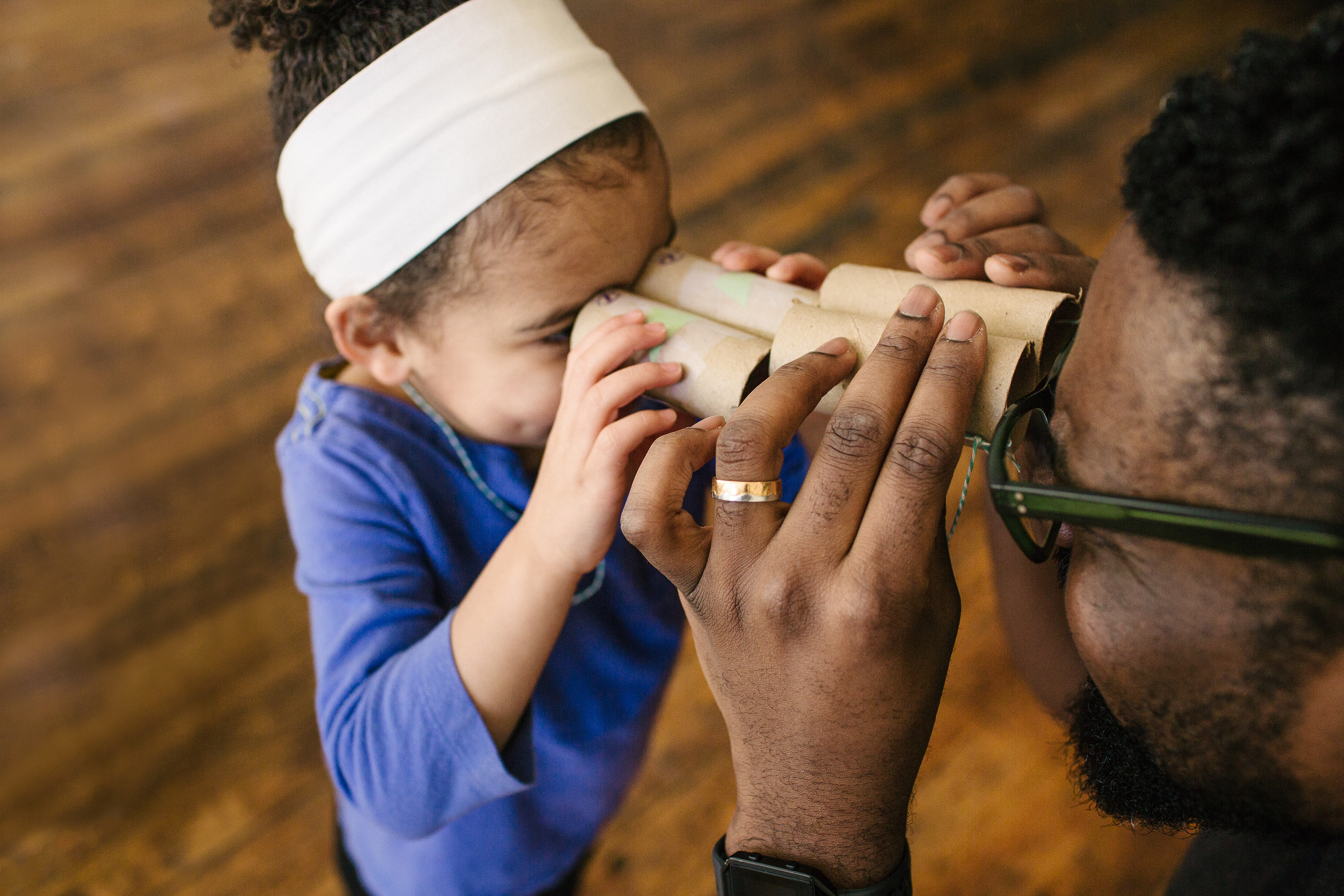
![[placeholder image]](https://sixtyinchesfromcenter.org/wp-content/uploads/2020/12/Quenna-Lené-Barrett_Headshot-300x99.png)
